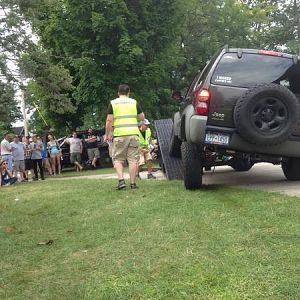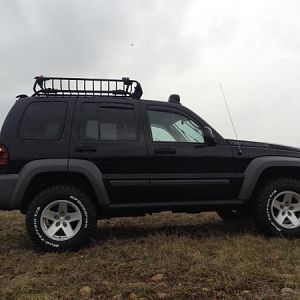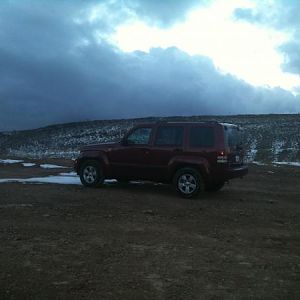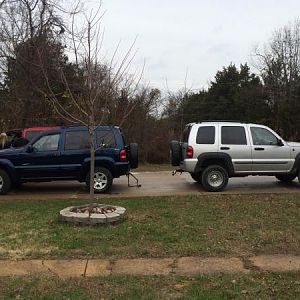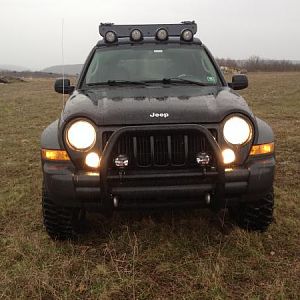You are using an out of date browser. It may not display this or other websites correctly.
You should upgrade or use an alternative browser.
You should upgrade or use an alternative browser.
Exhaust?
- Thread starter mkusmc
- Start date
Disclaimer: Links on this page pointing to Amazon, eBay and other sites may include affiliate code. If you click them and make a purchase, we may earn a small commission.
- Joined
- Feb 15, 2006
- Messages
- 7,347
- Reaction score
- 7
Definitely won't pass 2010 federally-mandated DOT vehicle inspections if cat-conv is missing.............
Unless he pays the inspection center and they put the hose in another vehicle's pipe... and call it a day
- Joined
- Feb 15, 2006
- Messages
- 7,347
- Reaction score
- 7
Are you sure it is the muffler, but not your driving style?  Because muffler is yelling at you saying "get your foot of the gaaaaaaaaarrrhhhzzzzzz"
Because muffler is yelling at you saying "get your foot of the gaaaaaaaaarrrhhhzzzzzz"  That's what I noticed when I first got my muffler.
That's what I noticed when I first got my muffler.
maverick7321
Full Access Member
Are you sure it is the muffler, but not your driving style?Because muffler is yelling at you saying "get your foot of the gaaaaaaaaarrrhhhzzzzzz"
That's what I noticed when I first got my muffler.
That is what I noticed also!
maverick7321
Full Access Member
I just had it replaced with straight pipe, not loud at all.
You know with no muffler at all you stand a chance of hurting the engine in the KJ for it was not designed to be run straight pipe with no muffler.
http://www.jeepkj.com/forum/showpost.php?p=385084&postcount=30
CRD Joe
Full Access Member
I left my cat alone, but I added a 2.5" cat back no muffler straight pipe. Sounds great and it cut out a lot of weight.
You must be registered for see images attach
Last edited:
Auberon
Full Access Member
Trucks with breathing difficulties?
I am puzzled.
I believe as does Jim Allen that a lot of myths are linked to exhaust systems.
A motor has to pump air in and waste gas out.
Back pressure = pumping loss (not a direct quote but from an idea from a really beaut book "Jeep 4x4 Performance Handbook" by Jim Allen).
So my take on this is that we are using exhaust gas to pump heaps of cool fresh air in on the clean air side to improve combustion which - so we need to (within the realms of pollution controls varying from State to State, country to country) and the KJ Jeeps system has been manufactured as generically suitable as possible to comply with these demanding laws & silencing.
They could not be tailor-built to each law & provide the best possible aspiration and exhaust combination due to manufacturing cost.
So we already have a relatively high degree of resistance with our turbos and just the pipe let alone some states having Cat Converters in diesels (open to correction there as I don't hail from California)....how much more do we need?
The Jeep engineers have to compromise their way through this myriad, as they do for compliance with the handling laws, lights etc.
In terms of diameter, I wud not say that bigger is better. Gas flow is a tad touchy in IC engines and on some slower speed engines the timing of the pulse travelling along the pipe aids scavenging, as does the legth of the exhaust.....this is very complex & starts at the valve(s).
The claim that back pressure is necessary has been around for many years & I'm very uneasy about how this fits with high speed, high efficiency diesel engines.
I would be appreciative of real figures on just how much we need to supply with an exhaust system at different points as I am of the understanding that a muffler is like a truck with emphasima.....easy breathing makes for easy running.
Cheers
Auberon
I am puzzled.
I believe as does Jim Allen that a lot of myths are linked to exhaust systems.
A motor has to pump air in and waste gas out.
Back pressure = pumping loss (not a direct quote but from an idea from a really beaut book "Jeep 4x4 Performance Handbook" by Jim Allen).
So my take on this is that we are using exhaust gas to pump heaps of cool fresh air in on the clean air side to improve combustion which - so we need to (within the realms of pollution controls varying from State to State, country to country) and the KJ Jeeps system has been manufactured as generically suitable as possible to comply with these demanding laws & silencing.
They could not be tailor-built to each law & provide the best possible aspiration and exhaust combination due to manufacturing cost.
So we already have a relatively high degree of resistance with our turbos and just the pipe let alone some states having Cat Converters in diesels (open to correction there as I don't hail from California)....how much more do we need?
The Jeep engineers have to compromise their way through this myriad, as they do for compliance with the handling laws, lights etc.
In terms of diameter, I wud not say that bigger is better. Gas flow is a tad touchy in IC engines and on some slower speed engines the timing of the pulse travelling along the pipe aids scavenging, as does the legth of the exhaust.....this is very complex & starts at the valve(s).
The claim that back pressure is necessary has been around for many years & I'm very uneasy about how this fits with high speed, high efficiency diesel engines.
I would be appreciative of real figures on just how much we need to supply with an exhaust system at different points as I am of the understanding that a muffler is like a truck with emphasima.....easy breathing makes for easy running.
Cheers
Auberon
lancesr
New Member
My 2 cents is that the turbo provides enough back-pressure, plus I could care less about the EPA! Mine has a nice 3" straight pipe, a little over the top in volume but sure is nice when you stand on it!!
krazykarl454
New Member
i agree 100% back psi is bogus. gassers want an exhaust that scavanges. and diesels in no way shape or form want back psi. back psi on a turbo engine jus increases EGT temps. same reason a bigger exhaust houseing lowers EGTs.the one guy was rite about the combustion engine just being an air pump is rite on
twack
Full Access Member
back pressure is only for naturally aspirated engines like the 3.7. And yes for NA engines it is very necessary, but for a turbocharged car you turbo will create any back pressure needed, The way a turbocharged engine feeds itself it makes it so you ont need/or even want back pressure due to the enormous amounts of pressure you are already puting into the engine
summitrider800r
New Member
Backpressure is a really misunderstood word. From what I know its not back pressure that's required on a non-turbo engine but exhaust velocity. Exhaust velocity affects the "scavenging" effect. This effect actually ***** the exhaust out of the cumbustion chamber just before the exh. valve closes, leaving more room for intake air. That velocity is determined by the amount of exhaust, the size of pipe, and the resistance to flow in the pipe. The resistance in the pipe is bad all around. It slows the exhaust no matter what. The size of pipe is tuned depending on the engine and its purpose. A smaller pipe will create higher velocities at lower RPM's, producing more low end power. In exchange the high RPM power will suffer due to the large amounts of exhaust going thru the small pipe. A Large pipe will create higher velocities at higher RPM, producing more top end power. In exchange the low end power will suffer due to the lack of exhaust velicity and "scavenging". Its with this that manufacturers try to hit the "middle ground" with pipe size or even use pipe size to influence the power/torque curves of an engine.
On the note of no backpressure causing exhaust valve damage. This is apparently true when dealing with some older leaded fuel engines. The only way the exhaust system will damage exhaust valves is if the pipes off the block are too short. This could cause cold air to contact the exhaust valve right after it has closed, possibly cracking or breaking it. This is why dragsters have 'zoomies' on them.
For a turbo charged engine pipe size is less important because the turbo affects the exhaust flow. There is much less scavenging because the turbo creates resistance to exhaust low. However, the power gained by the turbo more than makes up for the power lost.
On that note lets look at what effects the exhaust system has on the performance of the turbocharger itself. The difference in exhaust pressure between the turbine inlet and outlet is what forces the gases through the turbine and spinning it. So we want to keep the outlet (tailpipe) side of the turbo at as low of a pressure as possible. That means a bigger pipe with the least resistance. Having lower outlet resistance will mainly lead to faster spool up and less turbo lag when you punch the pedal. You might see higher boost in some systems(not the 2.8 CRD).
Now for a little more on the turbo itself. The 2.8 CRD uses a Variable Geometry Turbocharger (VGT). This means that the engines computer can alter the geometry of the exhaust housing by opening and closing the vanes. This in turn regulates the exhaust pressure on the inlet side of the turbo allowing for higher pressures at lower RPM and faster spoolup. It also serves to protect the turbo from 'overspeed' by not letting the pressure get too high. This is the same function a 'wastegate' serves on non-VGT turbos. If the turbo overspeeds too much it goes BOOM. Because of the VGT system a modified exhaust will do little to change max boost pressure without also modifing the engines computer tuning.
So to sum it up for a turbo diesel. You will see very little negative effects from upping the pipe size from the turbo back. As far as removing the cat conv or muffler, performance will be gained but that's a choice you must make based on your local emmission and sound laws.
I hope this can help clear up some of the 'myths' dealing with exhaust systems in 4-stroke engines.
If someone thinks i'm misinformed or wrong on any of these points feel free to bring that up and we can figure out what the proper answer is.
Joey
On the note of no backpressure causing exhaust valve damage. This is apparently true when dealing with some older leaded fuel engines. The only way the exhaust system will damage exhaust valves is if the pipes off the block are too short. This could cause cold air to contact the exhaust valve right after it has closed, possibly cracking or breaking it. This is why dragsters have 'zoomies' on them.
For a turbo charged engine pipe size is less important because the turbo affects the exhaust flow. There is much less scavenging because the turbo creates resistance to exhaust low. However, the power gained by the turbo more than makes up for the power lost.
On that note lets look at what effects the exhaust system has on the performance of the turbocharger itself. The difference in exhaust pressure between the turbine inlet and outlet is what forces the gases through the turbine and spinning it. So we want to keep the outlet (tailpipe) side of the turbo at as low of a pressure as possible. That means a bigger pipe with the least resistance. Having lower outlet resistance will mainly lead to faster spool up and less turbo lag when you punch the pedal. You might see higher boost in some systems(not the 2.8 CRD).
Now for a little more on the turbo itself. The 2.8 CRD uses a Variable Geometry Turbocharger (VGT). This means that the engines computer can alter the geometry of the exhaust housing by opening and closing the vanes. This in turn regulates the exhaust pressure on the inlet side of the turbo allowing for higher pressures at lower RPM and faster spoolup. It also serves to protect the turbo from 'overspeed' by not letting the pressure get too high. This is the same function a 'wastegate' serves on non-VGT turbos. If the turbo overspeeds too much it goes BOOM. Because of the VGT system a modified exhaust will do little to change max boost pressure without also modifing the engines computer tuning.
So to sum it up for a turbo diesel. You will see very little negative effects from upping the pipe size from the turbo back. As far as removing the cat conv or muffler, performance will be gained but that's a choice you must make based on your local emmission and sound laws.
I hope this can help clear up some of the 'myths' dealing with exhaust systems in 4-stroke engines.
If someone thinks i'm misinformed or wrong on any of these points feel free to bring that up and we can figure out what the proper answer is.
Joey
Last edited:
yakman4
New Member
I've been running straight pipe cat back for 60k no problems what so ever on my 06 crd it's a little louder when you put your foot into it but at highway speeds no difference.
Bama KJ
New Member
no back pressure
New to this site , but i use to work at a turbo shop. If the turbo has a outlet of 2.5 than you need a true 2.5 exhaust all the way out. NO CATconverter. D%$# EPA
New to this site , but i use to work at a turbo shop. If the turbo has a outlet of 2.5 than you need a true 2.5 exhaust all the way out. NO CATconverter. D%$# EPA
retmil46
Full Access Member
In a lot of states, NC for certain, at least as far as diesels are concerned, a turbo DOES meet the legal requirements as far as having a muffler installed - ie, you can run a straight pipe out the back on a turbo diesel and still be entirely legal.
FWIW, the original warranty (if anyone out there still falls under the original warranty) only covers the exhaust system back to and including the cat - it DOES NOT include the muffler - so you can do whatever you wish to the stock muffler without fear of voiding the warranty - but that's probably a moot point as old as these vehicles are now.
The stock muffler that came on the CRD's (at least the 05's) is the same muffler they used for the little 2.4 L four ****** gas engine - I've got a pdf of the exploded parts drawings for the 05 KJ's on my old computer, and the part numbers are an exact match. I looked inside the stock muffler when I had it removed and replaced with a straight-thru Aeroturbine - baffled and restricted big time, nothing but a soot trap.
As far as the cat - fail-safe bet is to leave it as-is - no telling what future inspection requirements will be - some areas that are "EPA Non-Attainment Zones" for air quality will do a full-up inspection of it, making sure the cat AND IT'S INTERNALS are still in place - other areas will simply verify by sight that the OUTER CASING is installed in the exhaust system, and people have gotten away with gutting the internals out of it and leaving the shell in place.
FWIW, the original warranty (if anyone out there still falls under the original warranty) only covers the exhaust system back to and including the cat - it DOES NOT include the muffler - so you can do whatever you wish to the stock muffler without fear of voiding the warranty - but that's probably a moot point as old as these vehicles are now.
The stock muffler that came on the CRD's (at least the 05's) is the same muffler they used for the little 2.4 L four ****** gas engine - I've got a pdf of the exploded parts drawings for the 05 KJ's on my old computer, and the part numbers are an exact match. I looked inside the stock muffler when I had it removed and replaced with a straight-thru Aeroturbine - baffled and restricted big time, nothing but a soot trap.
As far as the cat - fail-safe bet is to leave it as-is - no telling what future inspection requirements will be - some areas that are "EPA Non-Attainment Zones" for air quality will do a full-up inspection of it, making sure the cat AND IT'S INTERNALS are still in place - other areas will simply verify by sight that the OUTER CASING is installed in the exhaust system, and people have gotten away with gutting the internals out of it and leaving the shell in place.
Similar threads
- Replies
- 2
- Views
- 220
- Replies
- 2
- Views
- 1K
Latest posts
-
-
Rear windshield on 06' Liberty won't close and lock in most of the time.
- Latest: cruisingram2000
-



